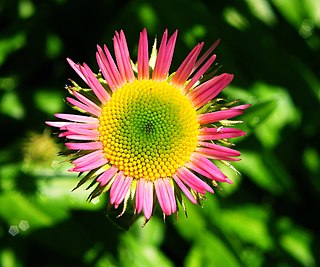
Astereae is a tribe of plants in the family Asteraceae that includes annuals, biennials, perennials, subshrubs, shrubs, and trees. They are found primarily in temperate regions of the world. Plants within the tribe are present nearly worldwide divided into over 250 genera and more than 3,100 species, making it the second-largest tribe in the family behind Senecioneae.

Aphanostephus (dozedaisy) is a genus of flowering plants in the family Asteraceae.
Benitoa is a genus of flowering plants in the family Asteraceae.

Corethrogyne is a genus of flowering plants in the family Asteraceae.
Cuniculotinus is a genus of flowering plants in the family Asteraceae.
Gundlachia, commonly called goldenshrub, is a genus of flowering plants in the family Asteraceae.
Kemulariella is a genus of flowering plants in the family Asteraceae.
Lorandersonia, commonly called rabbitbush, is a genus of North American flowering plants in the family Asteraceae.
Neonesomia is a genus of North American flowering plants in the aster tribe within the sunflower family.
Oonopsis, or false goldenweed, is a genus of flowering plants in the family Asteraceae.

Oreostemma is a genus of flowering plants in the family Asteraceae. Species are found in western North America, with two endemic to California.

Rayjacksonia is a genus of North American flowering plants in the family Asteraceae. It is one of several genera with the common name tansyaster.

Stenotus is a genus of flowering plants in the family Asteraceae. There are four species, all native to western North America. They are known commonly as mock goldenweeds.
Toiyabea is a genus of North American plants in the aster tribe within the daisy family. The genus is named for the Toiyabe Mountains in the US state of Nevada. The only known species is Toiyabea alpina, the alpine serpentweed, native to the Toiyabe and Toquima Mountains of central Nevada.
Tonestus, common name serpentweed, is a genus of North American flowering plants in the family Asteraceae.

Xanthisma, common name sleepy-daisy, is a genus of flowering plants in the family Asteraceae.
Xanthocephalum is a genus of North American plants in the tribe Astereae within the family Asteraceae.
Xylothamia, the desert goldenrods, is a genus of flowering plants in the family Asteraceae. Until 2003, it was held to contain nine species of shrubs native to deserts of Mexico and the southwestern United States. However, it seems to contain at least two groups. Four species are related to Gundlachia and may be moved to that genus. Plants of the World Online class it as a synonym of Gundlachia. The relationships of the other five species is not quite as clear. All nine species do belong in the subtribe Solidagininae.

Chrysothamnus stylosus, called pillar false gumweed, or resinbush, is a species of flowering plants in the tribe Astereae within the family Asteraceae. It is native to Arizona and Utah in the southwestern United States.
Chrysothamnus scopulorum, called Grand Canyon glowweed or evening-daisy , is a North American species of flowering plants in the tribe Astereae within the family Asteraceae. It has been found only in northern Arizona and southern Utah.








